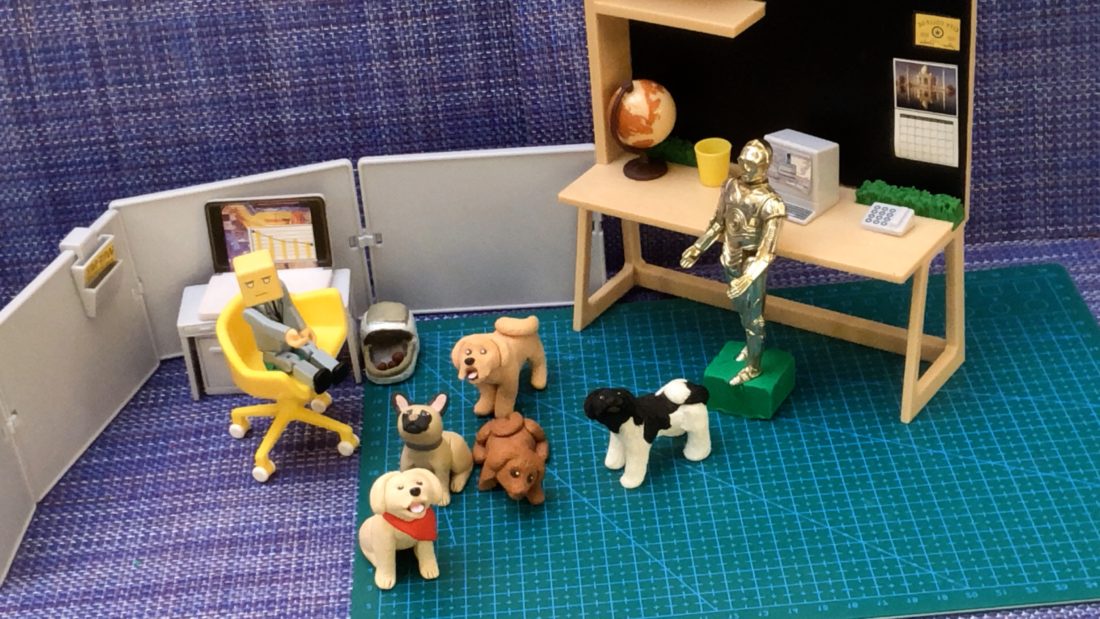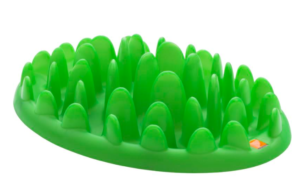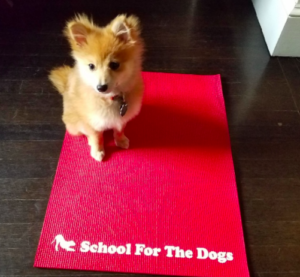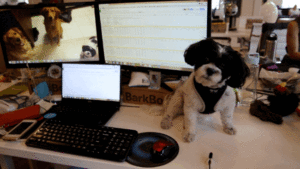
30 Apr8 tips for training the perfect office dog

In the latest episode of our podcast, we interviewed Carly Strife, one of the co-founders of Bark, the company behind BarkBox (you can check it out at the bottom of this post). Bark's Manhattan office is dog friendly, which means that everyone is on the same page about making sure that the dogs are comfortable there. Trying to turn your dog into a cubicle companion? Here are some ways you can train your dog to be the perfect workplace pet.
1. Feed your dog at work
Dogs are constantly making associations — that's a big part of what learning is about! So, if you want your dog to like a new place, it's a good idea to help her make good associations with the place by pairing it with something she already likes, like mealtime. If you get in the habit of feeding your dog her breakfast at work, she might be particularly keen on getting to work, which might help you get there with alacrity, too. Make sure that you feed your dog in a spot where other dogs will not bother her while she is eating.
2. Give meals in slow food bowls

Feeding meals in a toy like the Northmate Green Feeder can help harness a dog's energy during the workday.
Rather than feeding in a bowl, I suggest making workplace mealtime last longer by giving meals in a toy like the Northmate Green Feeder. I always recommend feeding in toys, as I think it's helpful to give a dog a kind of “job” to do while eating; dogs like to work, and I'd rather they satiate that “need a job” itch at mealtime rather than channeling that energy into jobs they hire themselves for, like chasing the UPS man. While there are lots of good “work to eat” toys out there, I like toys like the aforementioned Northmate for offices because a dog won't usually make a big mess while eating from it, you can use it with either wet or dry food, and it's easy to wash and store.

3. Make sure your dog has a “sticky” spot

Simba on his “sticky spot” mat.
I think it's great that the offices at Bark have desks that can accommodate crates or dog beds under them or on them. It's definitely wise to have a spot where your dog can chill and feel safe, with you nearby. In addition to their bed or crate, I suggest having a small blanket or mat on which your dog can learn to chill. The benefit of something light and portable is that you can bring it to the conference room for a meeting, or to a colleagues' desk. You can “condition” your to like being on this spot simply by feeding meals on it. The benefit of it being small and portable is that you can bring it home and practice with it there, too.
4. Keep your dog on a long leash
This point might be controversial in some workspaces, but, for safety's sake, I caution against dogs free roaming in offices. At Bark, most of the dogs aren't kept on leash… and one did nearly follow me from the bullpen into elevator when I left. Unless you have your dog in a private or semi-private area where there is a door or some other kind of barrier between the dog and the elevator or front door, I think it's wise to have your dog tethered. A long tether will give him lots of space and freedom (or as much as you want him to have). I suggest something lightweight so that it isn't burdensome. If your dog has a tendency to chew his leash, you can have a lightweight metal leash at its end.

The Treat & Train is a great office-place tool.
5. Use a remote feeder
There are only a thousand reasons why I'm obsessed with the Treat & Train, which is a remote-controlled treat dispenser. I highly recommend it for a dog who is hanging out under a desk in a crate. If there are multiple dogs in an office, I suggest having it in or atop a dog's crate so that it can't be accessed by multiple dogs, as there is less of a likelihood of resource guarding if your dog isn't worried about any other dog taking his food. I suggest having two remotes, one on you, and then one velcro'd by the front door or elevator along with instructions that anyone entering the office should push its button, triggering it to dispense a few nibbles. This way, your dog will make the connection that people coming in and out of the office means good stuff happens under the desk. Sure beats having a dog who bum rushes every new client who walks in, right?

(There are a lot of Bluetooth and wireless-connect treat dispensers on the market right now, and most of them have cameras and speakers and other perks. However for the purpose of this kind of training, I definitely like the Treat & Train best. It works on a radio signal — there are four channels, so you can have up to four in a single office without accidentally triggering someone else's. I also like the Pet Tutor, which has some advantages, the big one being that it is very quiet. But at School For The Dogs we generally prefer using the Treat & Train, as they are sturdier and all-around easier to use.)

Barkbox dog Bella enjoys her desk spot
6. Keep treats off the desk
The Bark offices have lots of different levels where dogs can hang out, and I think that's great, as it is a way that dogs can all be together but still have their own spaces defined by being at different heights. They also allow the dogs to sometimes chill on the desks, which I think is cool. However, if you're going to have dogs on a variety of surfaces, it's best to keep treats in drawers or in pockets. This will reduce scavenging and help keep dogs from invading each other's spaces. Keeping treats off desks can also help a dog NOT develop the habit of looking for food on other table-like surfaces, like the kitchen table or counter.
7. Establish a buddy
Have a co-worker who doesn't have a dog but is gaga for yours? That's great! Especially if that person's work station is near yours. Make sure your dog spends some portion of each work week at his “buddy's” desk on his sticky spot (see point 3 above). Let him enjoy a meal there, or take some treats from his “buddy” on the regular. This way, if you ever have to run out urgently and you can't bring your dog, your dog will be less likely to feel abandoned among strangers. If your dog is especially sensitive to change, you could even ask your “buddy” to sit at your desk if you have to go out.
I think it's especially wise to have a designated “buddy” who doesn't have a dog already, this way your dog can benefit from more of his “buddy's” attention. But it's also great if your dog has dog friends in the office, of course. In our interview, Carly mentions that there are lots of people in the Bark offices who take their dogs for walks together, even though the dog's humans don't sit near each other and may not be tight. Co-walking can be a great way for two dogs to get to know each other, and people too! And it's nice to have someone else who can remind you that it's time for a pee-break, and someone who your dog is comfortable walking with if you need to work through walk-time.
8. Practice good elevator manners
Think about the elevator door from your dog's point of view: It opens suddenly, at irregular intervals, and you never know who will be revealed on its other side. In an office with dogs, a strange dog could be revealed on the other side, and then the strange dog and your dog will have to be sharing an already small and crowded space! How are they supposed to politely greet each other in such tight quarters! So many bad things could happen. I'm having a panic attack just thinking about it. Reduce my stress by training your dog to face away from the door. This can be done by practicing nose-to-hand touches, or working on maintaining eye contact in the elevator. If you can teach a dog to nose target a post-it, you can teach your dog spend the ride targeting the wall, starting by put a post-it opposite the elevator door. Or else … take the stairs!



